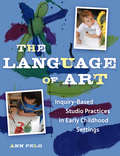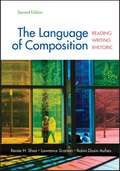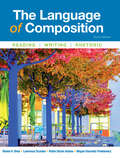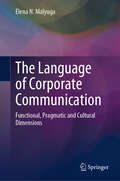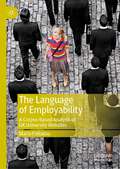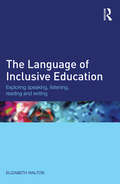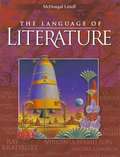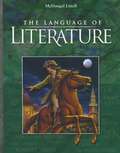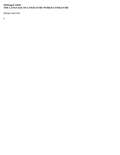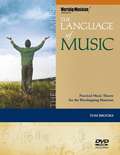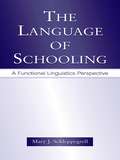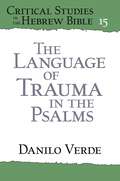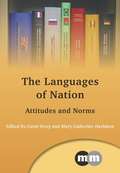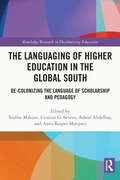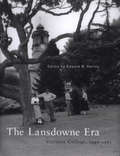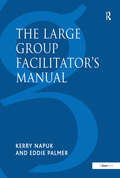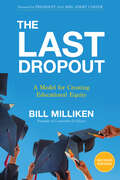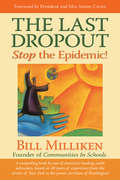- Table View
- List View
The Language of Art
by Ann PeloIncorporate inquiry-based practices into your early childhood classroom or family child care program. Inspired by an approach to teaching and learning born in Reggio Emilia, Italy, The Language of Art emphasizes investigation anchored by drawing, painting, and other art activities. It provides:advice on setting up a studio space for art and inquirystudio explorations designed to give children a basic fluency in artsuggestions for documenting children's developing fluency with art media and its use in inquiryguidelines for using children's new-found fluency as a tool for investigation.Even if you use a space not designed specifically for art instruction or even for an early childhood program, The Language of Art shows how you can simply start where you are.
The Language of Choice Theory
by William GlasserIn this companion volume to the bestselling Choice Theory, Dr. William Glasser and his wife, Carleen Glasser, have imagined typical conversations in real-life situations--between parent and child, two partners in a relationship, teacher and student, and boss and employee. On the left-hand page is a typical controlling order or threat, and on the right a more reasonable version, using choice theory, which is more likely to get a favorable response from the child, lover, student, or employee. Through these examples, the principles of choice theory come alive.
The Language of Choice Theory
by William GlasserIn this companion volume to the bestselling Choice Theory, Dr. William Glasser and his wife, Carleen Glasser, have imagined typical conversations in real-life situations--between parent and child, two partners in a relationship, teacher and student, and boss and employee. On the left-hand page is a typical controlling order or threat, and on the right a more reasonable version, using choice theory, which is more likely to get a favorable response from the child, lover, student, or employee. Through these examples, the principles of choice theory come alive.
The Language of Composition: Reading, Writing, Rhetoric
by Renée H. Shea Lawrence Scanlon Robin Dissin AufsesNIMAC-sourced textbook
The Language of Composition: Reading, Writing, Rhetoric
by Lawrence Scanlon Robin Aufses Renee Shea Megan HarowitzFor over a decade, The Language of Composition has been the most successful textbook written for the AP® English Language and Composition Course. Now, its esteemed author team is back, giving practical instruction geared toward training students to read and write at the college level. The textbook is organized in two parts: opening chapters that develop key rhetoric, argument, and synthesis skills; followed by thematic chapters comprised of the finest classic and contemporary nonfiction and visual texts. With engaging readings and reliable instruction, The Language of Composition gives every students the opportunity for success in AP® English Language. AP® is a trademark registered and/or owned by the College Board, which was not involved in the production of, and does not endorse, this product.
The Language of Corporate Communication: Functional, Pragmatic and Cultural Dimensions
by Elena N. MalyugaThis book explores diverse cultural and linguistic landscapes, unraveling the fusion of language, culture, and corporatism. It breaks new ground by examining lesser-known linguistic-cultural aspects of corporate communication. It provides deeper insights into conversational practices, cultural variations, and gender-specific speech aggression within the corporate realm. The book delves into functional aspects, such as corporate terminology and stylistic techniques, as well as the pragmatic dimension with humor and emotive language. Offering a unique perspective on corporate language, it deepens understanding of semantic dynamics and emphasizes language's power to meet diverse communication needs. The book is a must-read for corporate professionals, linguists, scholars, business leaders, communication consultants, and educators teaching the language of business and corporate communication. It is also an invaluable asset for anyone seeking to navigate the intricacies of corporate communication in today's globalized business landscape.
The Language of Employability: A Corpus-Based Analysis of UK University Websites
by Maria FotiadouThis book employs a corpus-based Critical Discourse Analysis (CDA) methodology to analyse the language used by university careers services in the UK. Drawing on a corpus which includes the public-facing websites of careers services from 24 Russell Group and 34 Post-92 universities, the author highlights some of the potentially problematic 'common-sense' views and ideas that are currently promoted to students using these services. She argues that the language used by university websites promotes neoliberal ideology and encourages the denaturalisation of such language. This book will be of interest to linguists, sociologists, education scholars, and scholars who are otherwise interested in the notion of employability.
The Language of Inclusive Education: Exploring speaking, listening, reading and writing
by Elizabeth WaltonThe Language of Inclusive Education is an insightful text which considers the writing, speaking, reading and hearing of inclusive education. Based on the premise that humans use language to construct their worlds and their realities, this book is concerned with how language works to determine what we know and understand about issues related to in/exclusion in education. Using a variety of analytical tools, the author exposes language-at-work in academic and popular literature and in policy documents. Areas of focus include: What inclusive education means and how it is defined How metaphor works to position inclusive education How textbooks construct inclusive education How we use language to build what we understand to be difference and disability, with particular reference to AD(H)D and Asperger’s Syndrome Listening to children and young people as a means to promote inclusion in schools Woven through this volume is the argument for a more critical awareness of how we use language in the field that we call ‘inclusive education’. This book is a must-read for any individual studying, practicing or an interest in inclusion and exploring the associations with language.
The Language of Literature (Grade #10)
by Mcdougal LittellA great collection of literature from different authors ranging from the classic ones to the modern ones.
The Language of Literature (Grade #7)
by James Marshall Arthur N. Applebee Judith A. Langer Andrea B. Bermúdez Sheridan Blau Rebekah Caplan Peter Elbow Susan HyndsBecoming an Active Reader involves more than just enjoying the power of storytelling. To understand and appreciate the literature in this book, you'll need to learn and apply the reading strategies.
The Language of Literature (Grade #8)
by James Marshall Arthur N. Applebee Judith A. Langer Andrea B. Bermúdez Sheridan Blau Rebekah Caplan Peter Elbow Susan HyndsBecoming an Active Reader involves more than just enjoying the power of storytelling. To understand and appreciate the literature in this book, you'll need to learn and apply the reading strategies listed here. As you begin to learn the strategies and how to use them, stop from time to time to monitor how well they are working for you. If it helps your reading, modify the strategies as necessary to suit your needs.
The Language of Literature (Grade #9)
by James Marshall Arthur N. Applebee Judith A. Langer Sheridan Blau Andrea B. Bermudez Rebekah Caplan Peter Elbow Susan HyndsThe Language of Literature provides the readers with abundant pleasuring reading materials with a rich content such as The Power of Storytelling, Passages, Voices of Experience, All in the Family, A World of Mysteries, The Classic Tradition. An additional attractive feature of Student Resource Bank contains Glossary of Literary Terms, Writing Handbook, Communication Handbook and Grammar Handbook.
The Language of Literature: World Literature (Language of Literature)
by McDougal-Littell Publishing StaffA selection of literature; formal and integrated assessment in literary analysis, reading, and writing; and integrated technology, including audio, video, computer, and Internet resources, makes literature accessible to students of all learning styles.
The Language of Music: Practical Music Theory for the Worshipping Musician (Worship Musician Presents Series)
by Tom BrooksIn The Language of Music, Tom Brooks demystifies and explains the basic building blocks of music in a simple, clear, straightforward way – essential knowledge that every worship musician needs to perfect his craft. The book offers a practical, real-world approach to all the fundamental concepts; music theory and harmony, chord construction, scales, key signatures, chord relationships, transposition, modulation, chart reading, and basic arranging, along with tips on how to practice more efficiently and rehearse more effectively, and much more. The focus is on contemporary praise and worship; music that is inspiring the church in the 21st century.
The Language of Organizational Styling
by Lionel WeeThe ways in which commercial organizations and service providers 'style' themselves - creating the image they wish to portray to their potential consumers - is a long-established area of research in the fields of sociology and business studies. However language also plays an important role in organizational styling, something which until now has been largely overlooked in the literature. This is the first book-length study of the linguistics of organizational styling, looking at the language and semiotic resources used by holiday resorts, pharmaceutical companies, restaurants and insurance companies in order to project their identities, and style themselves. It discusses in detail a number of case studies and presents an innovative take on the notion of style, as well as bringing together work from linguistics, business studies and sociology. This interdisciplinary book will be of interest to scholars and advanced students in sociolinguistics, and scholars of sociology and business studies.
The Language of Schooling: A Functional Linguistics Perspective
by Mary J. SchleppegrellThis book is about how language is used in the context of schooling. It demonstrates that the variety of English expected at school differs from the interactional language that students use for social purposes outside of school, and provides a linguistic analysis of the challenges of the school curriculum, particularly for non-native speakers of English, speakers of non-standard dialects, and students who have little exposure to academic language outside of schools. The Language of Schooling: A Functional Linguistics Perspective builds on current sociolinguistic and discourse-analytic studies of language in school, but adds a new dimension--the framework of functional linguistic analysis. This framework focuses not just on the structure of words and sentences, but on how texts are constructed--how particular grammatical choices create meanings in the different kinds of texts students are asked to read and write at school. The Language of Schooling: A Functional Linguistics Perspective*provides a functional description of the kinds of texts students are expected to read and write at school;*relates research from other sociolinguistic and language development perspectives to research from the systemic functional linguistics perspective;*focuses on the increasing linguistic demands of contexts of advanced literacy (middle school through college);*analyzes the genres typically encountered at school, with extensive description of the grammatical features of the expository essay, a gatekeeping genre for secondary school graduates;*reviews the grammatical features of disciplinary genres in science and history; and*argues for more explicit attention to language in teaching all subjects, with a particular focus on what is needed for the development of critical literacy.This book will enable researchers and students of language in education to recognize how the grammatical and discourse features of the language of schooling construct the content areas, role relationships, and purposes and expectations of schools. It also will enable them to better understand the nature of language itself and how it emerges from and helps to maintain social structures and institutions, and to apply these understandings to creating classroom environments that build on the strengths students bring to school.
The Language of Trauma in the Psalms (Critical Studies in the Hebrew Bible)
by Danilo VerdeOver the last few decades, the field of trauma studies has shed new light on biblical texts that deal with individual and collective catastrophe. In The Language of Trauma in the Psalms, Danilo Verde advances the conversation, moving beyond the emphasis on healing that prevails in most literary trauma studies. Using the lens of cognitive linguistics and combining insights from trauma studies and redaction criticism, Verde explores how trauma is expressed linguistically in the book of Psalms, how trauma-related language was rooted in ancient Israel’s external realities, and how psalms helped define Yehud’s cultural trauma in the Persian period (539–331 BCE). Rather than assuming the psalmists’ personal experiences are reflected in these texts, Verde focuses on the linguistic strategies used to express trauma in the Psalms, especially references to the body and highly dramatic metaphors. Current analyses often approach trauma texts as tools intended to help sufferers heal. Verde contends that many group laments in the book of Psalms were transmitted not only to heal but also to wound the community, ensuring that the pain of a previous generation was not forgotten.The Language of Trauma in the Psalms shifts our understanding of trauma in biblical texts and will appeal to literary trauma scholars as well as those interested in ancient Israel.
The Languages of Nation
by Carol Percy Mary Catherine DavidsonThis collection brings together research on linguistic prescriptivism and social identities, in specific contemporary and historical contexts of cross-cultural contact and awareness. Providing multilingual and multidisciplinary perspectives from language studies, lexicography, literature, and cultural studies, our contributors relate language norms to frameworks of identity beyond monolingual citizenship - nativeness, ethnicity, politics, religion, empire. Some chapters focus on traditional instruments of prescriptivism: language academies in Europe; government language planners in southeast Asia; dictionaries and grammars from Early Modern and imperial Britain, republican America, the postcolonial Caribbean, and modern Germany. Other chapters consider the roles of scholars in prescriptivism, as well as the more informal and populist mechanisms of enforcement expressed in newspapers. With a thematic introduction articulating links between its breadth of perspectives, this accessible book should engage everyone concerned with language norms.
The Languaging of Higher Education in the Global South: De-Colonizing the Language of Scholarship and Pedagogy (Routledge Research in Decolonizing Education)
by Sinfree Makoni Anna Kaiper-Marquez Cristine G. Severo Ashraf AbdelhayBy foregrounding language practices in educational settings, this timely volume offers a postcolonial critique of the languaging of higher education and considers how Southern Epistemologies can be used to further the decolonization of post-secondary education in the Global South. Offering a range of contributions from diverse and minoritized scholars based in countries including South Africa, Rwanda, Sudan, Qatar, Turkey, Portugal, Sweden, India and Brazil, The Languaging of Higher Education in the Global South problematizes the use of language in various areas of higher education. Chapters demonstrate both subtle and explicit ways in which the language of pedagogy, scholarship, policy, and partcipiation endorse and privelege Western constructs and knowledge production, and utilize Southern theories and epistemologies to offer an alternative ways forward – practice and research which applies and promotes Southern epistemologies and local knowledges. The volume confronts issues including integrationism, epistemic solidarity, language policy and ideology, multilingualism, and the increasing use of technology in institutions of higher education. This innovative book will be of interest to researchers, scholars, and postgraduate students in the fields of higher education, applied linguistics, and multicultural education. Those with an interest in the decolonization of education and language will find the book of particular use.
The Lansdowne Era
by Edward HarveyProviding background and context, and bringing together a multiplicity of voices, Edward Harvey documents how one Canadian college responded to the important developments of the time - post-war prosperity, rapid urbanization, massive expansion in post-secondary education, the "baby boom," the emergence of a "youth culture." Individual chapters by distinguished alumni reflect on the legacy of Dean Emeritus Peter Lawson Smith, discuss the buildings and architecture of the era, highlight initiatives to build the institution's art collection, and look at teaching from the perspective of a young faculty member.
The Large Group Facilitator's Manual: A Collection of Tools for Understanding, Planning and Running Large Group Events
by Kerry Napuk Eddie PalmerMost organizations are adept at using small groups - witness the widespread use of teams. Yet, how do you work with 20 to 500 people at a time? How would you involve all stakeholders in a critical issue or the organization's future? How can you generate contributions, consensus and commitment from the bottom up? People want to contribute but often are frustrated through a lack of opportunity or means. Large Group Processes allow people to participate over things that matter to them. Participation leads to commitment and commitment to ownership. Working with large groups is relatively new, but these processes are proving very effective with positive outcomes. Audiences can be customized with stakeholders who might be inside or outside the organization, such as employees, customers, suppliers, shareholders, the general public and any other interested parties. Applications are wide-ranging, touching on almost every aspect of organizational life. The Large Group Facilitator's Manual offers you a blueprint for planning, preparing, running and reporting successful large group events. The authors walk you through six different processes from concept to step-by-step facilitation with sample invitations, checklists and even scripts. It is the first facilitator's guide to cover so many processes with such detailed instructions.
The Last Academy
by Anne ApplegateWhat is this prep school preparing them for?Camden Fisher arrives at boarding school haunted by a falling-out with her best friend back home. But the manicured grounds of Lethe Academy are like nothing Cam has ever known. There are gorgeous, preppy boys wielding tennis rackets, and circles of girls with secrets to spare. Only . . . something is not quite right. One of Cam's new friends mysteriously disappears, but the teachers don't seem too concerned. Cam wakes up to strangers in her room, who then melt into the night. She is suddenly plagued by odd memories, and senses there might be something dark and terrible brewing. But what? The answer will leave Cam--and readers--stunned and breathless, in this thrilling debut novel.
The Last Archer
by S. D. SmithA Green Ember story set during Heather and Picket's arrival at Cloud Mountain, The Last Archer follows the journey of Jo Shanks. Jo is a gifted archer with a burden on his back and a fire within. <P><P>Eager to see the Longtreaders receive justice, he travels from his Halfwind Citadel home to a Cloud Mountain poised on the brink of war. What he finds there will confront his convictions and test his resolve as the war begins and King Jupiter's heir is revealed. <P><P>A kingdom in the balance. An arrow aimed at the heart of darkness. Who will take the shot?
The Last Dropout: A Model for Creating Educational Equity
by Bill MillikenA revised and updated edition of an exploration into the foundational principles, impact, and real-life success stories from Communities In Schools.Since 1977, Communities In Schools (CIS) has reached more than one million students and their families annually approximately 3,000 American schools, surrounding them with a community of support and empowering them to stay in school and achieve in life.In The Last Dropout, CIS founder Bill Milliken offers nine key principles that Communities In Schools has tested over four decades. Interwoven are his real-world life stories, a journey that began in the turbulent 1960s as a youth worker and evolved into a handful of groundbreaking "Street Academies" that became the CIS movement with a national network of hundreds of local affiliates. Milliken also shares transformative stories about how CIS leaders have adopted these principles in their own communities, with stunning results.Milliken's guiding philosophy has been "It is relationships, not programs, that change children," and it is a principle that has served as a beacon in the movement for educational equity and success.
The Last Dropout: Stop The Epidemic!
by Bill MilikenDid you know that we’re battling an epidemic* . . . ? <P><P>Almost one-third of all high-school students fail to graduate with their class; among minorities, the dropout rate is almost 50 percent. Dropouts are more likely than their peers to be unemployed, live in poverty, have poor health, depend upon social services, and go to jail. <P><P>The combined loss of income and revenue to the American economy froma single year’s dropoutsis about $192 billion. But there is a solution to the dropout crisis that is proven, effective, replicable, and sustainable! Communities In Schools (CIS) reaches more than one million at-risk students and their families annually in more than 3,000 American schools. These kids would fall far below the national average for every measure of student success. Yet 98 percent of CIS-tracked students stayed in school. Why? What makes the difference? <P><P>The Last Dropout offers nine key principles that Communities In Schools has tested over three decades. Interwoven are the dramatic life stories of CIS founder Bill Milliken and his colleagues, a journey that began in the turbulent 1960s as youth workers with a spiritual mission struggled to turn around the lives of dropouts and addicts. <P><P>It traces the evolution of the CIS movement from a handful of groundbreaking "street academies" to a national network of hundreds of local affiliates. The Last Dropout also features stories about how CIS leaders have adopted these principles in their own communities, with stunning results! *From The Silent Epidemic (Bridgeland, Dilulio, and Morrison, 2006)
